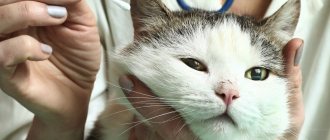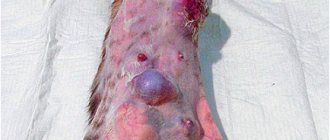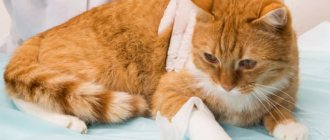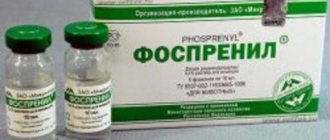Description
It is absolutely clear that without any special reason, a lump does not appear on a cat’s neck under the jaw. However, some cat owners, having discovered such a formation in their pet, are in no hurry to show it to a specialist and do not take any action to treat it. In rare cases, a lump on a cat’s neck may disappear on its own without treatment, but you should not let the development of such a formation take its course and you should consult a specialist as soon as possible.
The formation of any compaction or tumor is a consequence of a certain pathological process occurring in the animal’s body. Such a compaction can be either benign or malignant. However, even a harmless formation under the influence of certain factors can develop into a cancerous tumor.
Externally, the lump looks like a round or oval compaction that stands out from the rest of the skin with a reddish tint. It is easily detected by palpation. The density of a lump on a cat’s neck depends on its location:
- If the seal is between the muscles and the skin, it will be soft and mobile.
- The lump located in the muscle layers will be harder and more immobile.
According to medical terminology, such growths or lumps are called lipomas. Those of them that are close to the skin can be eliminated very simply through surgery. However, if the lipoma is deeper and develops very actively, then its treatment will be more difficult. There is no point in delaying therapy, because such a lump can very quickly degenerate into a malignant one - liposarcoma, which can metastasize to nearby organs.
It is impossible to determine the nature of the seal by its appearance, since it may be a common wart. Such formations can be quite large in size, however, the cat often does not experience pain. Without timely treatment, the lump develops very quickly and begins to interfere with the animal, and its attempts to independently get rid of the interfering seal can only worsen the situation.
Associated symptoms
Additional symptoms allow the veterinarian to assume the nature of the pathological formation.
- If the formation is benign, it may not manifest itself in any other way.
- Also, the wen does not cause other symptoms. But in some cases (if it grows) it is recommended to remove it, since a harmless growth can eventually transform into a malignant tumor called liposarcoma.
- If the balls on the chin or paws are caused by an inflammatory process after an insect bite, the animal will suffer from severe itching.
It's possible that small bumps on your cheek or breastbone are caused by allergies . With this cause of growths, vomiting is also observed due to intoxication of the body.
Lipoma
Lipoma is a benign formation that can appear on any part of the animal's body. It is capable of growing, reaching impressive sizes, but does not cause pain to the cat and does not metastasize to other organs.
The lipoma is soft to the touch and has clear boundaries. Symptoms depend entirely on its location and the mechanical pressure on the surrounding tissues.
Despite the fact that a lipoma is practically harmless, when it forms on the limbs, it can cause lameness, and if located on the carotid artery, it can lead to the death of a cat from suffocation.
The condition of an animal that has developed a lipoma is usually normal and does not cause discomfort.
Dermatological diseases
The cat's body is susceptible to autoimmune diseases. In such cases, the immune system attacks the body's own tissues where the target cells are located. Dermatoses of this type include:
- Pemphigus foliaceus. The intercellular epidermal tissue is affected, which leads to the appearance of pustular rashes on the face. May be accompanied by hyperthermia, lethargy, and refusal to eat. A biopsy of the affected areas is necessary.
- Common pemphigus. The epidermis stratifies with the formation of bubbles filled with liquid, which burst, turning into ulcers on the nose, lips and in the oral cavity. May be fatal. A histological examination of the damaged mucosa is required.
- Erythematous pemphigus. Most often, only the nose is affected. Accompanied by pigmentation disorders, rashes, ulceration of the nasal planum, bridge of the nose and bridge of the nose, and the formation of scabs.
- Pemphigus vegetans. A relatively mild form of dermatosis. Main symptoms: rash and blisters.
- Systemic lupus erythematosus. Skin manifestations are observed in the discoid form, involving the nose, ears, eyelids, lips. The process begins with changes in pigmentation and redness, then ulcers form. Systemic disorders include: damage to the hematopoietic system (anemia, decreased blood clotting), kidneys, joints, gastrointestinal tract, central nervous system. Tests for antinuclear antibodies and a biopsy of the epidermis are necessary.
- Vasculitis. The disease affects blood vessels, which leads to a deterioration in the blood supply to tissues and their subsequent death. Most often, the nose, lips, tip of the tail, ears, paw pads, and genitals are affected.
- Cold agglutinin disease. Reason: at low ambient temperatures, red blood cells interact with immunoglobulins. The same areas are damaged as with vasculitis. They acquire a bluish coloration, pigmentation is disrupted, and hair falls out. In severe cases, necrosis may occur.
Causes
In the vast majority of cases, a lump on a cat’s neck occurs in old age. Most veterinarians attribute this to the aging process of the animal's body. However, there are cases when owners discovered a large lump on the neck of a cat whose age did not exceed 5 years. The reasons for this can be very different. The main prerequisites for the occurrence of a pathological neoplasm include:
- bad ecology;
- eating low-quality products;
- predisposition at the genetic level;
- injuries or severe bruises;
- the presence of subcutaneous mites in the body.
Signs of lipoma
A lump on a cat's neck forms between the muscle layer and the skin layer. There the formation of nodules or capsules occurs. Most often, the contents of such capsules have a liquid consistency. It can be “doughy” and mobile, not causing discomfort to the animal, or it can be denser and cause pain. Subcutaneous formations may also include degenerated tissue.
The temperature of the soft cone most often corresponds to the cat's body temperature. Dense buds are usually hotter. If an initially soft formation has become compacted, the temperature of the animal’s entire body may rise and signs of intoxication of the body may appear. These signs include the following: the cat becomes weaker, refuses to eat, and becomes irritable.
Particular attention should be paid to buds that grow quickly.
Risk group
As stated above, older cats are most likely to develop lumps on their necks. At the same time, there are the following risk factors that can cause the development of such formation in younger individuals:
- the presence of endocrine disorders;
- the presence of parasites in the body;
- excess body weight.
Only a veterinarian can accurately determine the cause of the development of a lump under a cat’s neck. He also prescribes a treatment regimen, since it is strictly forbidden to independently treat any formations on the animal’s body.
Abscess
Also, in a cat, a lump on the neck under the skin may be an abscess. In this case, the lump will be filled with pus. Most often, an abscess appears at the site of a wound or injury. It can also be the result of exposure to parasites that irritate the animal's skin.
Main symptoms of an abscess:
- the formation has a homogeneous structure;
- the temperature rises and the skin surrounding the affected area turns red;
- pressing on the formation causes pain to the cat.
Due to the fact that such a bump causes discomfort to the cat, he always tries to scratch it. If he cannot reach with his paws, he rubs the sore spot on the furniture.
By its nature, an abscess is a purulent inflammation, so as a result of its development, the pet begins to feel worse. The cat becomes either lethargic or too irritable, refusing to contact the person.
Hematoma at the withers
Often after injections, lumps appear on the skin. This happens in two cases - the injection is placed incorrectly or the injection solution is too thick.
The lump after an injection into the withers of a cat is not dangerous and acts as nothing more than an ordinary hematoma. It resolves after a few days and does not require specific treatment. You should consult a doctor if there is an increase in skin temperature around the lump, and the animal constantly tries to comb the sore area.
Among the reasons for the appearance of bumps on the neck and withers in animals, injuries should also be noted. If an animal walks freely on the street, it can fight with a fellow animal, and a seal forms at the site of the bite. Such an injury is dangerous with the risk of abscess formation, so it should be immediately treated with an antiseptic.
In all other cases, you should not try to treat the cat yourself, or hope that the lump will resolve. Only a specialist can make an accurate diagnosis and relieve the animal of discomfort.
Diagnostics
If a tumor appears in your cat's neck, you should immediately visit a veterinarian, since after a certain point it may rupture. In addition, if the lump reaches a large size, it can lead to suffocation.
After conducting a professional examination and certain studies, the veterinarian will be able to determine the nature of the formation and prescribe a course of treatment. As research, radiography and puncture biopsy of the contents of the lump are often performed. X-rays can reveal the presence of metastases, and a biopsy helps determine the nature of the compaction. The further treatment of the cat depends on the results of these two procedures.
A biopsy is performed by removing pathological materials from the formation. Before pumping out part of the contents of the lump, the cat is given local anesthesia. The sample taken is sent to the laboratory for cytological examination. Based on the results of this study, the doctor makes a diagnosis and, if necessary, prescribes surgery to excise or completely remove the formation.
Mastitis
A nursing cat may develop mastitis or mastopathy; often this disease is associated with the fact that the animal freezes while feeding outside. Mastitis can also be caused by non-nursing cats taking contraceptives. Lumps in the chest area sometimes grow quite large, they are painful, and can also cause fever and fever . Accompanying symptoms also include vomiting, diarrhea, and refusal to eat.
But veterinarians know how to cope with such a complication. The owners are only required to strictly comply with all the prescriptions of the course of treatment.
Treatment of abscesses
Before the lump on the cat's neck bursts, you should immediately begin treatment. In this case, only a veterinarian can help.
There is no preliminary treatment for such an abscess. After the examination, the cat is immediately sent to the surgeon. He opens the seal with a scalpel and cleans the cavity of pus. After this, antiseptic treatment of the wound is carried out. If necessary, the cat is given stitches and prescribed antibiotics to prevent the re-development of inflammation.
If left untreated, the abscess can open on its own. However, this is very dangerous for the animal, since it can lick the pus flowing from the wound. In addition, there is a high risk of infection.











